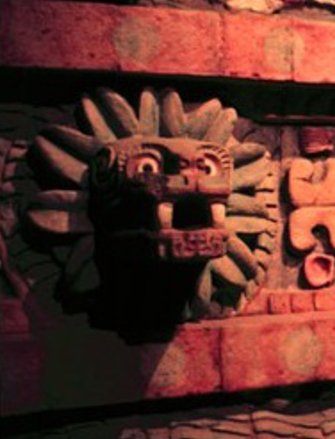
A stone representation of Quetzalcoatl, a pre-Columbian Mesoamerican deity. This photo was released into the public domain by its author, Aceofhearts1968 at Bulgarian Wikipedia.
The story that follows was written for @mctiller's Twenty-four Hour Short Story Contest. The prompt was irresistible: A gargoyle, from a top an ancient building, plots its coming escape into the real world. I came across this last night and tried to think of a catchy angle. So, this is what I came up with.
Thanks, @mctiller for prompting a vigorous exercise of my imagination.
The Mission
Along with the precious seeds, they had sealed her voice, her sight. They had also entombed the will to protect, preserve and propagate. She did not know the date of her eventual release. She only knew it was certain.
The design of her mission was exquisite. Pioneers had searched galaxies for carbon-rich planets. They had probed and tested resources. Silicon and carbon together would form the medium for germination of her fertilized eggs. Oxygen would be their essential fuel.
The pioneers had adapted easily to the environment of the green planet as they carried out reconnaissance. They had distributed themselves as spores and recorded habits of the dominant species, those who would be unwitting custodians of the mother pod.
Among the universal tendencies of this native species was the inclination to worship stone monuments, monuments that remained intact for centuries. The intrinsic durability of the monuments, enhanced by reverence status, would insure that the mother pod, hidden within, would be protected.
And so they sealed her spore-like being in stone. They modeled the vessel to resemble the grotesque physiognomy of icons to which inhabitants of the green planet offered ritual sacrifice. She remained for generation upon generation--silent, immobile, blinded. She bore witness, through heightened auditory sensitivity, to the savagery natives inflicted upon one another. Her vigilance was unrelieved by sleep, or feeding. Sleep was irrelevant and nourishment passively received from minerals that had been incorporated into her tomb.
As a witness she developed contempt for her caretakers. They, all the while, sanctified her tomb with blood and ceremony.
At first, there were great gatherings of tormentors and the tormented. She heard wailing and terror. She heard adulation, and celebration of ritualistic suffering. A disdain grew in her for this native species, they that destroyed their own. She reflected on the ferocity with which she protected each of the thousands of eggs in her care, every one a precise representative of half her genetic code. Each would be fertilized, when the time was right, with the other half of her code, and would be an exact replication of herself, an extension of her own being, as she was an expression of generations that had come before. A line of uninterrupted reproductive urgency.
As she remained encased in her tomb, millennia passed. Sounds outside changed. The blood-letting ceased. Voices faded. Subordinate species nested at the base of her stone monument. They defecated and mated in crevices that had been chiseled into the exterior of the shell. All of this she suffered with indifference. The behaviors were irrelevant to her mission. Her one, unalterable purpose was to protect her brood and deliver the eggs intact to an environment in which they could thrive.
Once, in all the years that passed, the ground shook and there was great tumult in the wildlife outside. But she remained unperturbed. Eventually, the voices of the dominant species returned. Blood no longer stained the ground in front of her tomb and adulation was replaced by gasps of wonder. She had become a curiosity, no longer an object of worship.
She waited, through the howling wind, the trembling earth, the attention and inattention of disparate species. She endured until her womb was ripe and the seeds were primed for fertilization. Thus ripened, they became hot and exuded a chemical corrosive to the stone that imprisoned her. Through the smallest opening forged by her seed, she at last exited. Her spore-like form escaped notice.
She found a hollow, secluded in the forest, and created a cavity deep enough in the planet's crust to access a rich silicon strain. Here she deposited and fertilized her eggs.
She watched over them for forty nights and forty days. At the end of that time, they took flight, thousands of them, her progeny, across the green planet. As time passed, they would incorporate carbon and oxygen into their own systems, so that they could produce more seed. This next generation was engineered to reproduce every sixty days. Soon the planet would be colonized. Available oxygen would be stripped from the atmosphere until the supply was exhausted and the need arose to move on, to find a new host. That exploratory work was already underway, as pioneers probed new planets, new resources.
This process of establishment, propagation and colonization was her species life cycle. They germinated for centuries, then reproduced rapidly and exploited the host planet until its potential for oxygen-dependent life was depleted. Thus they satisfied the one prerequisite for existence. They survived.
She was at peace, as the time of her extinction approached. This was her purpose. It was the most important role her kind could assign. She carried the future of her race. In the waning moments of life, she absorbed precious oxygen, and was satisfied.
